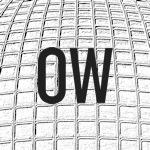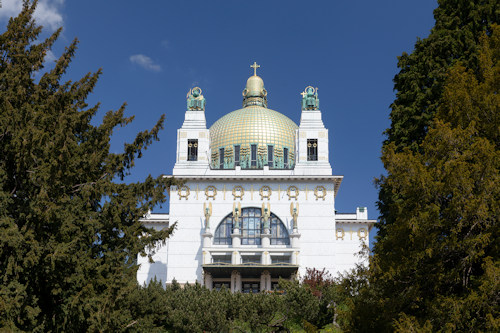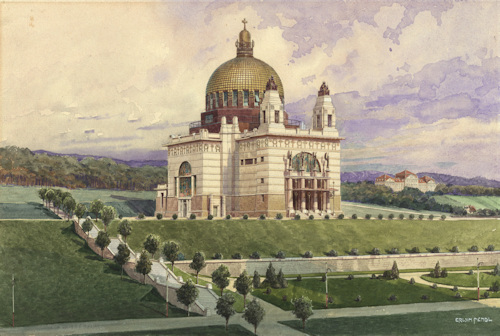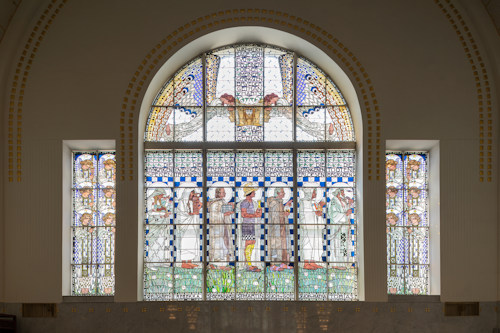
Vienna’s not short of a few gorgeous churches. But the early 20th century Kirche am Steinhof ranks as one of the most beautiful…and different, thanks to Otto Wagner’s unique design.
- Completed in 1907
- Europe’s first modern church
- A masterpiece in white and gold
- Pinnacle of Jugendstil architecture
- Book a historical walking tour* in Vienna
- See also:
A Jugendstil gem

(View from below; press photo by Lisa Rastl © Wien Museum)
On October 8th, 1907, a modern psychiatric hospital opened in Vienna with the catchy name of the “Niederösterreichische Landes-Heil- und Pflegeanstalt für Nerven- und Geisteskranke Am Steinhof” (now the broader Klinik Penzing hospital).
The father of modern architecture, Otto Wagner, drew up the plans for the new facility. He also designed the hospital church, which perched on top of the hill that sloped down through the numerous medical pavilions.
This Kirche am Steinhof proved to be arguably the architect’s most famous work, the jewel in the crown of Vienna’s Jugendstil era, and perhaps Europe’s first truly modern church.

(The church as painted by Erwin Pendl sometime immediately after its constrction; Wien Museum Inv.-Nr. 93322/20; excerpt reproduced under the terms of the CC BY 4.0 license)
Older places of worship in Vienna tend to be survivors of a dusky gothic past or explosions of frescoed baroque finery. The Kirche am Steinhof bears little resemblance to either.
Dedicated to St. Leopold, the monumental construction has a byzantine feel to it; the golden mosaic dome of the church appears first, rising above the surrounding trees and viewable from afar.
A pattern of copper rivets covers the white marble façade (Wagner’s Postsparkasse building would use a similar stylistic approach), and the entrance feels almost like a garden pavilion with its narrow supports. Albeit one with four golden-winged angels above it.

(View of the interior; press photo by Lisa Rastl © Wien Museum)
Inside, you emerge into a huge, bright, airy and spacious quadratic hall, where the marble, white and gold theme continues. For example, the ceiling forms a mosaic built of golden rivets and white squares outlined in the same precious colour.
Wagner and his associates designed everything here: from the architecture to the fittings and furniture. Which is also why you often see it called the Otto Wagner church.
The Jugendstil influence manifests everywhere, particularly in the geometric patterning (even in the floor), in the four giant brass and glass chandeliers, and in the main altar and pulpit.
That altar sits beneath a ribbed open gold canopy ringed by stylised angel faces and wings.
The geometric altar table has more pale marble and gold, and the characteristic geometric patterns decorate the pulpit, too, this time with added sapphire blue.
It all feels like a bridge between the past and the modern: entirely innovative but with the same attention to detail those baroque architects might have applied.

(The main altar; press photo by Lisa Rastl © Wien Museum)
That attention to detail includes the conceptual layout and internal features. For example:
- Short pews so medical staff can easily reach patients, with no sharp edges or corners where the latter might hurt themselves
- Floors and walls designed for easy cleaning with few places where dust might collect
- Mosaic glass windows (designed by none other than Koloman Moser, another stalwart of the Wiener Moderne) that ensure sufficient light fills the interior

(The stained glass windows designed by by Koloman Moser; press photo by Lisa Rastl © Wien Museum)
Even the giant mosaic behind the altar has traditional motifs translated into Jugendstil expression.
The more conservative echelons of Viennese must have reacted with some astonishment, but Wagner’s work was already seen at the time as a watershed moment in church building.
As one writer put it very simply in Die Zeit on October 8th, 1907 (my translation):
…an artist has created a masterpiece
Tickets and visitor tips
At the time of writing, a standard adult entrance ticket costs €5. Check the website (see below) for seasonal opening times, as these are usually limited to the warmer seasons. The church comes under the Wien Museum umbrella of sites.
You can, of course, walk around the outside at any time.
How to get to the church
Various public transport combinations get you to the Kirche am Steinhof. For example:
- Take the U3 subway to the final stop at Ottakring. Then catch the 48A bus up to Klinik Penzing. This delivers you to the front gates of today’s hospital, and you just walk up the hill through the medical pavilions to the top of the grounds.
You can also catch the 48A from the centre if you prefer not to change; get on at the Ring/Volkstheater stop.
- Alternatively, take the 46B bus from Ottakring to the Feuerwache Am Steinhof stop. Go into the park there and continue straight ahead. The wide path eventually curls around to the left and downhill. Go through the gates and turn left for the church.
The Steinhof park has lovely views over the Vienna woods.
- Take the U4 subway to Unter St. Veit and catch the 47A bus, which also goes to Klinik Penzing.
Address: Baumgartner Höhe 1, 1140 Vienna | Website